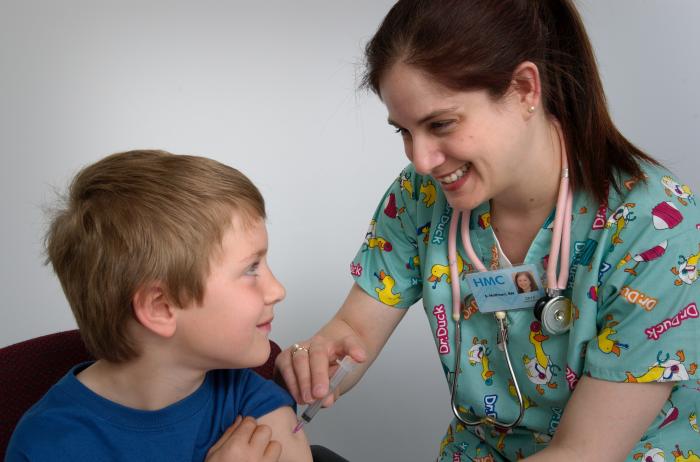A recent Centers for Disease Control and Prevention (CDC) study published in Pediatrics, “Influenza-Associated Pediatrics Deaths in the United States, 2004-2012” affirms the critical and life-saving role flu vaccine can play in protecting all children during flu season. This study broadens the body of knowledge around influenza-associated pediatric deaths (for children with and without high-risk medical conditions) and underscores several key issues for parents, care givers, clinicians, and the broader public health practice community. Although flu is usually a self-limited illness, severe complications such as pneumonia, encephalitis (inflammation of the brain) and myocarditis (inflammation of heart muscle), can result following flu infection.
Flu experts within the CDC’s Influenza Division analyzed the 830 flu-associated, lab-reported pediatric deaths during eight flu seasons from 2004-05 through 2011-12 to describe significant trends in influenza-associated pediatric deaths during that time period:
Fatalities occurred in children with and without high-risk medical conditions – This study highlighted that flu-associated illness can be fatal in children both with and without high-risk medical conditions. Out of 794 children with a known medical history, 43 percent did not have a high-risk medical condition. This finding highlights the importance of existing recommendations that all children should receive annual flu vaccination for prevention. Additionally, those who are hospitalized, who have a severe illness or who are at high-risk for complications should receive antiviral treatment as soon as possible. Parents and clinicians should be aware that flu can be associated with severe complications, even in otherwise healthy children (especially those under 2 years old).
Flu-associated deaths in children often occurred quickly – Most children died within one week of symptom onset, with deaths peaking in February or March annually. Thirty-five percent of children died before admission to the hospital, which includes 18 percent who died in the emergency department and 16 percent who died outside of the hospital. Children without high-risk medical conditions were more likely to die before hospital admission and within three days of symptom onset than those with high-risk medical conditions.
All children six months of age and older should receive an annual flu vaccine – The findings from this study underscore the importance of the CDC recommendation that all children six months and older receive an annual flu vaccination to prevent illness. Of the 511 children six months and older whose vaccination status was known, only 16 percent had been fully vaccinated for seasonal influenza. As shown in the data, many of these flu-associated deaths occurred among children who were not vaccinated. Overall, few children received the seasonal flu vaccine during the season they died, and during the 2009-10 H1N1 pandemic, very few children who died had received the pandemic flu vaccine. Furthermore, a 2003 survey of parents of healthy children referenced in the Pediatrics study found more than 50 percent believed flu infections to be more serious in healthy 70-year-olds than healthy one-year-olds, even though the risk of flu-associated hospitalization is comparable for both age groups. The public health community should continue to promote that all children, including healthy children that do not have high-risk medical conditions, receive the seasonal influenza vaccine annually.
Antiviral medication should be prescribed, as appropriate – The CDC recommends that children who are hospitalized, who have severe illness, or who are at high risk of complications (due to being younger than 2 years of age or because of medical conditions) should receive influenza antiviral treatment as early as possible. Among the 126 children who died during the 2010-11 and 2011-12 flu seasons whose treatment status was known, less than half (44 percent) received antiviral treatment. For those deaths that occurred after hospital admission in those same years, 62 percent received antiviral treatment.
The public health community should continue to educate parents and the broader public around the importance of vaccinations to prevent flu, the risk of flu to children, and the need for prompt antiviral medication for treatment of seasonal and pandemic flu. Local health departments are often known for their reach within communities and understanding of the populations they serve. Preparedness, immunization, and community outreach staff of local health departments should come together to promote such messages about flu to parents and other key populations. While every community is different, local health departments should continue to explore the most effective ways within their communities to share accurate and lifesaving information regarding vaccinations and antiviral medication for seasonal and pandemic flu.
NACCHO pediatric influenza resources:
- Perinatal 2009 H1N1 Influenza Vaccination Project, NACCHO Model Practice
- A Model for SLIV Clinics: The Dollars and “Sense” of Billing Private Insurers for Immunization Services, NACCHO Model Practice
- See-Ya-Later Fluagator School-Based Influenza Vaccination Program, NACCHO Model Practice
Other pediatric influenza resources:
- Prevention and Control of Seasonal Influenza with Vaccines, Center for Disease Control and Prevention
- Flu & Children/Youth with Special Health Care Needs – Flu Facts, National Center for Family Professional Partnerships: A Project of Family Voices, Inc
- Media Toolkit, National Center for Family Professional Partnerships: A Project of Family Voices, Inc
- Influenza Toolkit, American College of Obstetricians and Gynecologists
Recent news articles on this study:
- Even healthy kids can die from flu complications, USA Today
- Influenza can kill a healthy child in a matter of days, study finds, LA Times
- Children, Too, Need Flu Shots, New York Times
Attribution: The findings within this article were pulled from the Pediatrics study and CDC’s Spotlight article on those findings.









